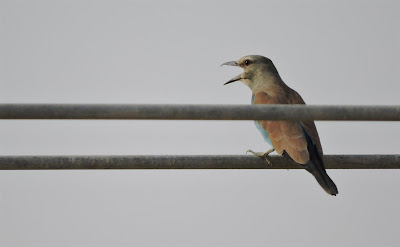This meant driving long distances in limited time. Wednesday was a day involving long distance driving. I went from Ghaftain to Haima then to Bahla, Ibri and finally to Buraimi.
Apart from birding early in the morning at Ghaftayn (see last blog) I managed two stops near Haima but not again until near Ibri.
The first stop was in the small park at Haima. Haima is surrounded by desert for many kilometres in all directions.
I had mixed fortunes there.
tree pipit
The good luck was that the workmen were giving watering the site. This was helpful in attracting birds such as pipits as well as the local house sparrow and laughing dove.
The bird above is a tree pipit but I consulted experts since it appeared to have some characteristics of olive-backed pipit which is a rare visitor normally to northern to Oman. However it is confirmed as the much more common tree pipit.
watering the park at Haima
The bad luck was dramatic. For three or four seconds a warbler was hopping along the side of the short hedge shown in the picture. I am pretty sure it was grasshopper warbler. The markings on the back were vivid. However there have only been seven records of the species in country and I would have needed a picture for my own satisfaction and the rarities committee. I won't claim this bird as my standard of proof is very high.
It must migrate through in much bigger numbers but is rarely seen. In this case the bird hopped into the hedge and I could trace it again.
The water attracted a grey heron out of nowhere. It was very reluctant to move on.
grey heron at Haima
Twenty kilometres north east of Haima on the Muscat road is the Haima Waste Disposal Site.
One part of the site is where dirty water is dumped and reeds grow. One of the first birds i saw was a surprise. Above the site was an osprey.
osprey
There are no fish on site so after a few minutes fruitless search it continued its migration.
spotted sandgrouse
Each time I have visited the site which has always mean in the morning, there have been large number of sandgrouse.
They drink from water at one end of the site cleaned by the reeds. They also seem to stay near the site before and after drinking.
This time I reckon there were 400 assorted sandgrouse present. The most abundant were spotted sandgrouse followed by chestnut-bellied sandgrouse with a few crowned sandgrouse.
red-backed shrike
Both Daurian shrike and Turkestan shrike were seen along with one red-backed shrike. The latter bird is much less common in Oman.
marsh harrier
Two marsh harrier were patrolling presumably looking for tired migrants.
moorhen
Moorhen obviously breed here and they are relatively tame. They are most easily seen around the few stretches of open water. In this same place a few waders were seen. These included common sandpiper, green sandpiper and little ringed plover.
I didn't stop again to bird for several hours. At least I drove during the hottest time of the day.
My next and last stop of the day was around 4pm south of Ibri in some scrubland.
red-tailed wheatear
The first bird I saw was a red-tailed wheatear. It is a common wintering bird in the north of the country but rare in Dhofar and certainly not seen this early in the season. This was perfect sign that I was in the different birding zone north of the desert.
desert whitethroat
It was also here I saw my first desert whitethroat of the season too.
desert wheatear
Red-tailed wheatear was not the only wheatear present. A desert wheatear was also seen.
I made it to Buraimi in good time. The next day, Thursday was the only day not involving long distance travel. I birded in that area all day. I will blog about what I saw next.




















































